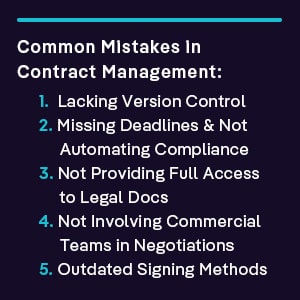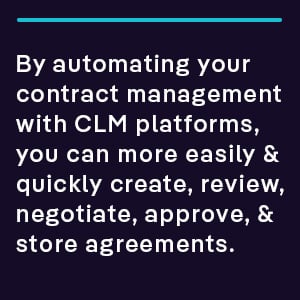No matter the size of your legal department and organization, errors are bound to occur at some point in the agreement lifecycle. In fact, even the most skilled contract manager is not insulated from these kind of mistakes, especially if they are relying on manual contracting practices. Poor contract visibility, for example, can lead to missed dates and milestones for the organization. And when left completely unchecked, this mistake and others can impact the bottom line and hinder revenue growth.
With that, here are the most common mistakes in contract management — and how automating your legal processes with the latest contract management software can prevent them.

Common Mistakes in Contract Management
When relying on paper-based systems or those with little or no technology, proper oversight of the contract lifecycle can be challenging. Using spreadsheets or disparate emails, for one thing, leads to not only blockers and bottlenecks, but also a serious lack of contract version control and compliance, access to all legal documents, involvement of commercial teams in negotiations, and efficient signing methods.
Lacking Version Control
Given how frequently contracts go back and forth between counterparties and internal teams, you may lack control of the many versions — or lose it altogether. This makes it difficult to know whether or not you captured all of the necessary changes during a negotiation, and identify which version of a contract is the approved one. And this makes it easy to send out a version of an agreement, which has not been approved for signage. Ultimately, having poor control over your contract versions — and having conflicting contractual information — can create risk and adversely affect your standing as a business. In fact, it is one of the most consequential contract management mistakes that organizations can make today.
Missing Important Deadlines and Not Automating Compliance
Failing to put in place a robust contract tracking system — and automating compliance — are the next biggest contract management mistakes. For example, by missing important deadlines like those for canceling an agreement, you can find yourself locked into a renewed contract that is against your business interests. And taken together, these missed renewal dates can affect your bottom line and frustrate business leaders. You can easily overlook important obligations and miss significant contract milestones. Very obviously, this lack of contract compliance can become a real nightmare for your organization, too.
Not Providing Full Access to Legal Documents
Do you store your contracts in filing cabinets, local hard drives, email chains and shared drives? Do you lack access controls, based on roles and user-permissions, on your contracts? If that is the case, you are not alone. But by using disjointed contract storage systems and overlooking these accessibility controls, you may find your sensitive agreements and associated documents falling in the hands of those who should not access them in the first place, and important files being misplaced or accidentally deleted. Even authorized users may have difficulty accessing contracts from any location, at any time, in the absence of a secure central repository for all of your agreements.
Not Involving Commercial Teams in Contract Negotiations
Failing to involve the appropriate stakeholders, like sales, procurement, and HR team members, is yet another significant mistake made when managing standard contracts. This is especially true during the contract negotiation process. Granted, you may be wary about including too many proverbial cooks in the kitchen and increasing the turnaround times for agreements. But by not welcoming other parties to collaborate on them, you may neglect the needs of various departments. You could find contracts completely misaligned with the realities across the enterprise and the long-term, strategic goals of your organization. What is more, you may create a situation in which business teams are only notified of their obligations second-hand or at the very last minute. And this can result in even greater risk for the business. The irony, of course, is that these same teams can offer insight into what responsibilities are the most reasonable — and what obligations can be met rather realistically. They can even help you negotiate contractual terms on indemnities, liabilities, and so much more.
Relying on Outdated Signing Methods
Finally, if you are still using traditional signing methods like wet signature or switching between various digital tools, your contracts may take too long to reach the signature stage. In such a traditional contract workflow, an agreement is typically created in Word, shared and negotiated over email, and signed using an outside e-signature tool — if not with wet ink. This also makes it difficult to stay on top of the contracting process: knowing whom the agreement is with, how long it has been awaiting signature, and who is blocking it? This makes it easy for agreements to lose some momentum or, in the worst case scenario, never see a signature at all.
How to Avoid These Contracting Mistakes
To overcome these particular pain points within your contract management process, it is crucial to understand how legal technology solutions like contract lifecycle management (CLM) systems can help you solve them.
Automating Your Contracts 
Just imagine being able to create a single source of truth for all of your agreements and keep your contractual information in one place. Picture being able to codify your contract management process with digital playbooks and prevent the need to generate contracts from scratch. How about being able to view the status of an agreement, find the most recent and accurate version of a contract, and better communicate with legal and other teams — in real-time — throughout the contracting process.
By automating your contract management with CLM platforms — as opposed to using manual processes or multiple technology tools — you can more easily and quickly create, review, negotiate, approve, and store agreements, for starters. With this contract automation software, you can then have more control of your contract versions, stay in contract compliance, keep track of all legal documents, involve business teams in contract negotiations, and have a more efficient contract signing process moving forward. As an added bonus, you can make sure your contracting process is consistent across all teams.
All of this means adopting and implementing a smart repository, where you can store all of your agreements securely and identify key dates and obligations in mere seconds. This means facilitating self-serve contracting, through dynamic, contracting templates, for all business users. And this means streamlining contract workflows, within a single legal platform, to reduce the usual bottlenecks and speed up the process altogether.
Overcoming Obstacles with ContractPodAi
So, do you want to avoid the common mistakes in contract lifecycle management? Want to boost efficiency, compliance, and profitability — at every stage of the contracting process? As mentioned above, automating your contracting with the best contract management software is the key. And fortunately, ContractPodAi has all the right contract management tools that can help you with this important legal digital transformation. Simply contact us today to request a demo or talk to one of our digital transformation experts.



